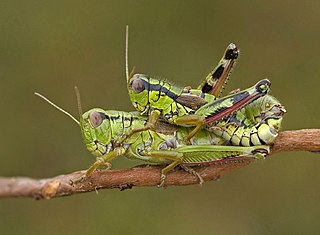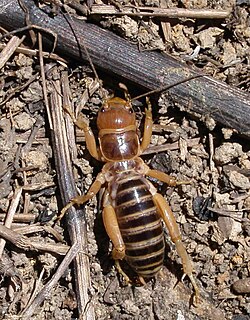
The Cooloola monster is a large burrowing orthopteran of the family Cooloolidae, a family erected to accommodate it because it is so dissimilar to other ensiferans. It was discovered in 1980 in the Great Sandy National Park in Queensland, Australia, by David C. Rentz. Further members of the genus Cooloola were later discovered at other locations in Queensland.
Bienkotetrix is a genus of groundhoppers in the family Tetrigidae comprising, as of December 2018, only a single species, Bienkotetrix tibetanus. As its name suggests, it occurs in Tibet.
Conozoa hyalina, the California Central Valley Grasshopper or just Central Valley grasshopper, was a species of grasshopper in the family Acrididae, now extinct. It was endemic to the United States.
Spaniacris deserticola is a species of grasshopper in the family Romaleidae known as the Coachella Valley grasshopper and spanistic desert grasshopper. It is known from a few locations in the deserts of southern California and just across the border in Sonora, Mexico.
Trimerotropis occulens, the Lompoc grasshopper, is a species of grasshopper in the family Acrididae. It is endemic to the United States.

Zaprochilus, the twig-mimicking katydids, is a genus of katydids in the subfamily Zaprochilinae. They are found in Australia. The genus Zaprochilus contains the following species:

Acridoidea is the largest superfamily of grasshoppers in the order Orthoptera with species found on every continent except Antarctica.

Hexacentrus is the type genus of bush-crickets in the subfamily Hexacentrinae. Most species of this genus occur in Southeast Asia and in Africa.

Tympanophora is a genus of bush-crickets, known as balloon-winged katydids, found in Australia. It is the only extant (living) genus in the subfamily Tympanophorinae.
Acilacris is a genus of shieldback katydids in the subfamily Meconematinae, found in southern Africa. It contains two subgenera, Acilacris and Aroegas, and nine species:

Stenopelmatoidea is a superfamily of insects in the order Orthoptera; in some older classifications this group was referred to as Gryllacridoidea.
The Tanaoceridae are an insect family in the monotypic superfamily Tanaoceroidea in the suborder Caelifera. They have been called desert long-horned grasshoppers.

Patanga is a genus of grasshoppers in the subfamily Cyrtacanthacridinae. Species are distributed throughout Asia: from India, China, Japan, Indo-China and western Malesia. The genus was named in 1923.
Microtettigonia is a genus of bush-crickets or katydids, endemic to Western Australia and known as micro katydids. It is the only genus of the subfamily Microtettigoniinae.

Austrosaginae, the sluggish katydids, are a subfamily of Australian insects within the family Tettigoniidae.
Oxyphlaeobella is a genus of grasshoppers in the family Acrididae, subfamily Acridinae. Species can be found in southern China and Indo-China.
Tympanophyllum is a genus of Southeast Asian leaf-mimicking katydids, insects in the tribe Phyllomimini. Species in this genus have been recorded from India to New Guinea. The genus was named in 1902.
Anabropsini is a tribe of king crickets. The tribe comprises over 40 species, has a broad distribution in Old and New World tropics, including Asia, Africa, Oceania, Central America, and South America.

Poecilopsyra is a monotypic genus of katydids or bush crickets native to Malesia. The single (type) species, Poecilopsyra octoseriata, was originally taken from Borneo.
Buforania rufa, sometimes called the rufous toadhopper, is a spur-throated grasshopper native to Western Australia.









